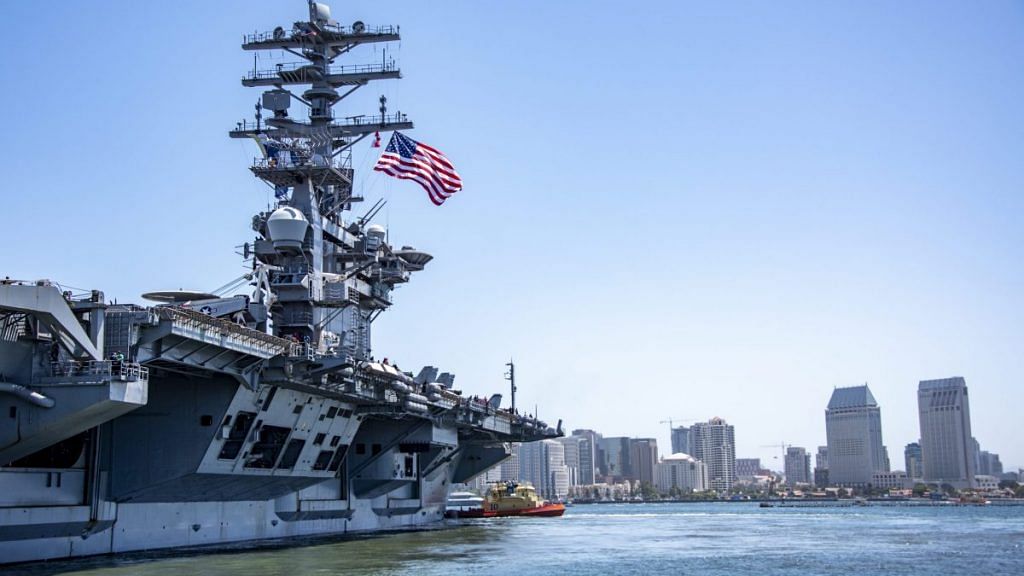For those who have kept themselves well informed of the Indian Navy’s preparedness, the high-end naval exercises conducted with US Navy’s nuclear-powered warship, is no surprise. If it sounds like being prepared for a fight, well, it undeniably is. The series of exercises, weeks after a similar joint drill with Japanese Navy in the Indian Ocean, are meant to improve interoperability and fine-tune ‘real-time air defence preparedness’.
USS Nimitz (CVN-68), commissioned in 1975, is one of the world’s largest warships and the Nimitz-class’ most powerful supercarrier. The joint exercises by Indian and US navies send strong signals to China not only about India’s increasing international clout but also its changed domestic political outlook.
The metamorphosis in the political atmosphere is evident. In July 2007, the USS Nimitz had docked near the Chennai port and there was a howl of protests by pro-China groups, self-styled environmentalists, the Communist Party and then-Tamil Nadu Chief Minister J. Jayalalithaa over fears of nuclear radiation. This time, there was not a word when the Nimitz joined Indian warships off the coast of Andaman & Nicobar Islands on 20-21 July.
Also read: Dropping lightweight tanks in Ladakh not enough. India’s forces need to be made more lethal
The message for China
The India-US naval exercise is a cause of worry and anxiety for Beijing — because it is meant to be. Close on the heels of the Covid-19 pandemic, India had to face a hostile People’s Liberation Army (PLA) at its borders in Ladakh and the standoff continues. If the infamous 2017 Doklam standoff has taught us anything about the Chinese strategy, it is that Beijing wants to keep New Delhi occupied in the northern frontier while it increases its footprints in the Indian Ocean, especially by creating naval bases.
China’s Galwan misadventure is a premeditated strategy to increase its strike capability and military advantage by creating PLA positions all along the Line of Actual Control (LAC) to the south of Siachen Glacier so that it can be at a vantage position, denying India military supremacy over Pakistan.
India will have to be prepared to deal with Beijing militarily not only in the northern sector but also in Pakistan-occupied Kashmir (PoK), which, according to military experts, is guarded mostly by the PLA — the Pakistan Army is merely a mute spectator in the infrastructure development projects. Accordingly, half of the Indian Navy’s 40 MiG-29K fighter jets have been reportedly deployed at airbases in the northern Ladakh sector to frustrate the China-Pakistan axis gaining military and strategic upper hand.
Also read: India has two options with stubborn China. The better one involves taking the battle to them
Start with Quad, move to South China Sea
While New Delhi has fortified the northern and western sectors, it cannot be content with this. India will have to kick start the Quad initiative and work with the existing members — the US, Japan, and Australia — to include other nations that are common to the South China Sea conflict — Vietnam, Indonesia, the Philippines among others — and important trade partners for us.
We have improved our military ties with the US and also strengthened security and strategic ties with Australia, an important partner in the emerging anti-China coalition. The Australia-India Mutual Logistics Support Arrangement and the Defence Science and Technology Implementing Arrangement are two very significant steps in deepening our ties in the emerging Indo-Pacific security and trade architecture.
India shares the security concerns of the countries in the South China Sea and strongly condemns China’s hegemonic moves. Clarifying the US’ position, the country’s secretary of state Mike Pompeo has said, “The world will not allow Beijing to treat the South China Sea as its maritime empire. America stands with our Southeast Asian allies and partners in protecting their sovereign rights to offshore resources, consistent with their rights and obligations under international law”. On Thursday, Pompeo, while urging nations around the globe to seek “accountability from the Chinese Communist Party”, was more direct in his attack, saying “the old paradigm of blind engagement with China has failed”.
Beijing has held that the situation in the South China Sea is very peaceful and stable and has accused the US of “stirring divisions”. It has also claimed that its negotiations with Asian countries, particularly those claiming equal sovereign rights in the South China Sea, are on track and would not welcome any ‘foreign’ intervention.
Also read: Opaque disengagement process at LAC and ‘we won’ noise will hurt India
Can’t allow a new axis
For New Delhi, any hegemonic supremacy for China in the South China Sea is a sure invitation for trouble in the Indian Ocean Region (IOR) and our legitimate leadership in the Indo-Pacific.
India’s IOR strategy should include a robust naval policy and diplomatic outreach towards the Indian Ocean Rim Association (IORA) countries. This will necessarily include increased economic arrangements, especially in developing military, civil and trade facilities in these countries.
It is important for New Delhi to convince the US, irrespective of who occupies the White House in the coming months, to reconsider its Iran policy. While India has managed to get a waiver for Chabahar port development and will have to shed lethargy and speed up the work, US sanctions and India’s strategic tilt towards the country should not disturb New Delhi’s equation with Tehran.
Any new realignment of forces such as the China-Pakistan-Turkey-Iran axis will be highly detrimental to India’s security and strategic position in the region. Neither the US nor India can independently take on a hegemonic and expansionist China, which has scant respect for global rule-based order and transparent trade system.
The author is a member of the National Executive Committee of the BJP and former editor of Organiser. Views are personal.
